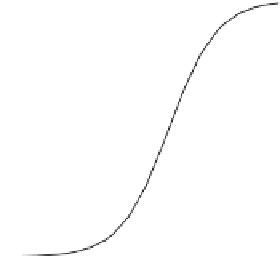Civil Engineering Reference
In-Depth Information
Fig. 4 Gas pressure
dependence of the effective
thermal conductivity of the
pore gas nitrogen in relation
to the thermal conductivity of
the free gas according to Eq.
(
6
) for different pore
diameters D and P = 1.
Typical s-shaped curves can
be observed in the log-linear
representation
1.0
0.5
0.1
μ
m
D = 10
μ
m
1
μ
m
0.0
10
-4
10
-3
10
-2
10
-1
10
0
10
1
10
2
10
3
p
g
/ 10
2
Pa
pore diameter D, the half-width pressure p
1/2
is shifted to higher values of the gas
pressure.
For thermal insulation materials at ambient temperatures, radiative heat transfer
could be described by the diffusion of photons and a radiative conductivity can be
defined as (Siegel and Howell
1972
):
n
2
T
r
q
e
R
ð
T
Þ
k
r
ð
T
Þ¼
16
3
ð
7
Þ
where k
r
the radiative conductivity, n the effective index of refraction, q the
density, e
R
*(T) the temperature-dependent effective specific extinction and T
r
the
mean radiative temperature. It is important to realise that the higher the density,
i.e. the more material can interact with the thermal radiation, and the higher the
effective specific extinction, the lower the radiative conductivity. Since in general
higher densities will be avoided because in this case the solid thermal conductivity
could increase, it is highly preferable to use so-called infrared opacifier. These
opacifiers consist of pigments, e.g. oxides, carbides or carbon blacks, which absorb
or scatter thermal radiation very efficiently and therefore reduce radiative heat
transfer. The effective specific extinction e
R
* is a material property and depends on
the chemical composition, the material size and shape.
In Fig.
5
, the gas pressure-dependent thermal conductivity of typical insulation
materials is depicted. For materials, like glass fibres and foams with large pores in
comparison with the mean free path of the gas molecules (for nitrogen at ambient
conditions about 70 nm), the saturation region where the diffusive heat transfer
occurs can be clearly observed for gas pressures above 10 mbar. Here, the thermal
conductivity is nearly independent of gas pressure. For microporous materials, like
precipitated and fumed silica with pore sizes in the range of the mean free path of
nitrogen, the thermal conductivity of the pore gas is already reduced and a total
effective thermal conductivity below or in the range of the thermal conductivity of
still air could be seen. The thermal conductivity values for the gas pressure-
































